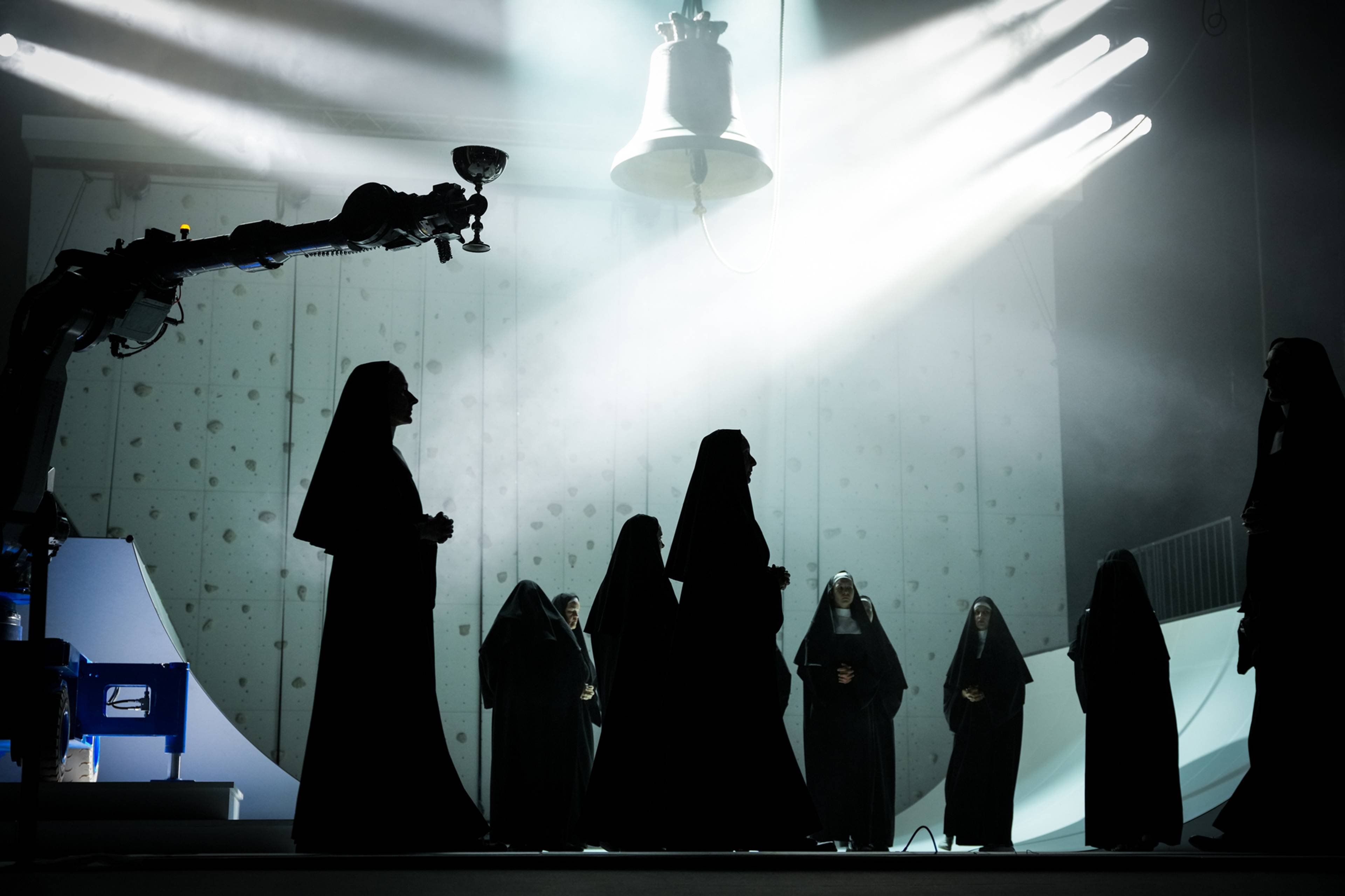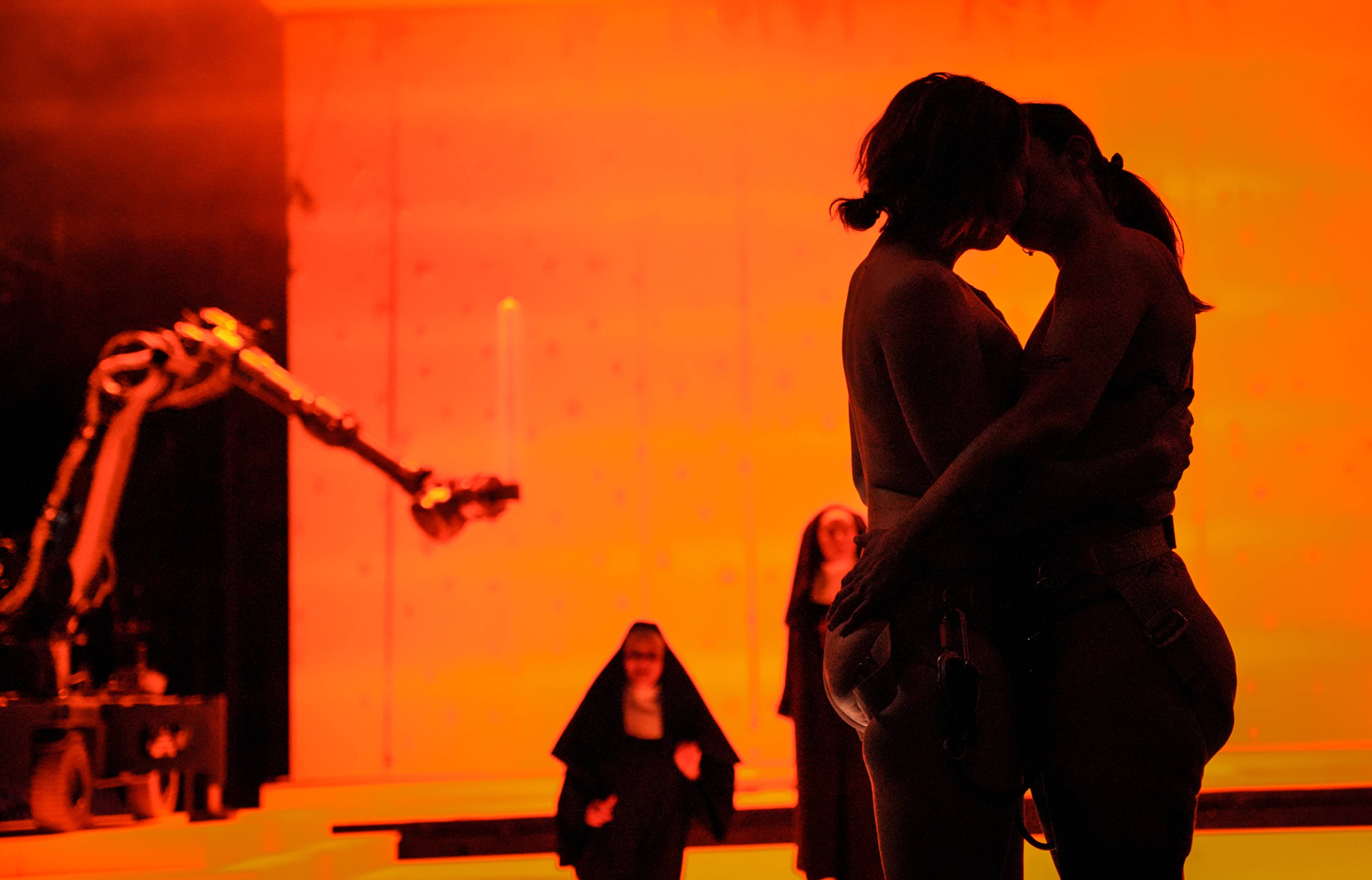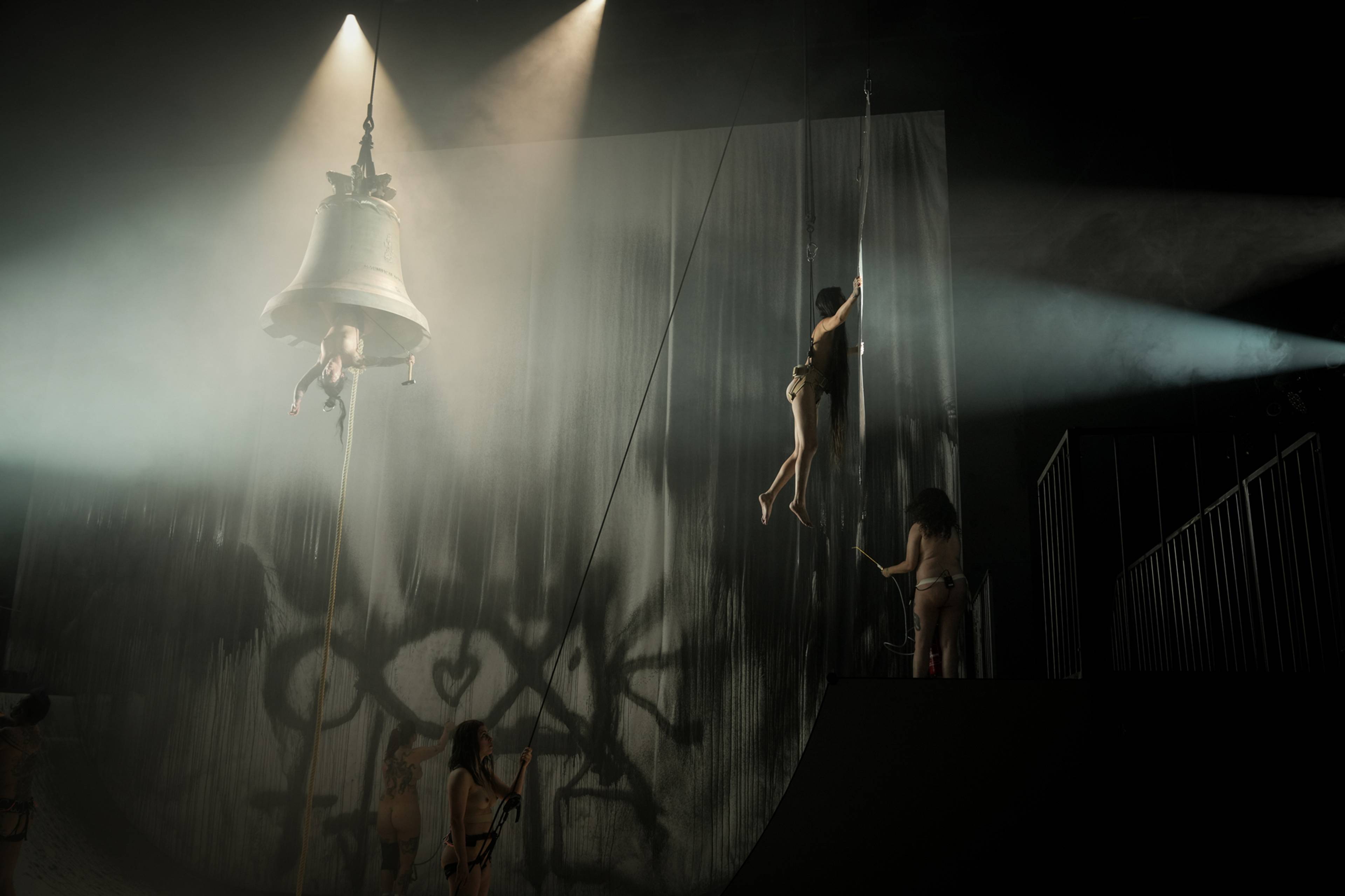In the foyer of the Mecklenburg State Theater, quite nunny-looking nuns accept confessions unbureaucratically, but are also available for selfies. The atmosphere is relaxed, with quite a few people from Berlin, press, and a handful of international curators mingling with Schwerin’s local opening-night subscribers. The air buzzes with the possibility of scandal. Because even if Paul Hindemith’s short opera Sancta Susana (1921) has long ceased being a sensation, it is certainly a good template for Florentina Holzinger (*1986), whose radically queer-feminist choreographies have made her the undisputed shooting star of current European theater. After all, it’s about the sexual desire of a nun – including an implied sexual act with the Savior.
And indeed, under the musical direction of the conductor Marit Strindlund, the evening begins more or less faithfully to Expressionist opera, barely more than twenty minutes long. In front of an altar, the convent nun Susanna (Cornelia Zink) slowly but surely descends into sexual ecstasy – the entire score a single crescendo – until, faced with another sister’s upraised cross and demands for chastity and obedience, she blurts out: “I am beautiful!” When further nuns rush over for her confession, she refuses with a triple “No!” “Satana!” they shout – but Susanna stands in “untouched majesty.” “So help me my Savior against yours!”
Singers from the Mecklenburg State Theater in Florentina Holzinger’s SANCTA, 2024
In the background, Holzinger’s crew has long since taken over the action. Where Hindemith, with Sigmund Freud’s interpretation of dreams in mind, had a single spider crawl across the altar as a symbol of repressed sexuality, naked female performers now climb up the stage’s back wall, kiss, and make love in a relief of open lust, a mountain of Venus.
The devil comes, the cross hangs overhead, everything red, with bits of fog and heavy metal – this must be hell. A crane robot holds the eternal light, or sometimes a cross; later, it serves as a wine shower and turns a Popess on her own axis. Half-naked nuns disco-roll in a half-pipe while the sisters’ choir sings “Kyrie Eleison” (Lord, have mercy). There are no symbols to decipher in Holzinger’s work, its celebration of directness completely unencrypted.
Pain, pathos, and a silly punchline coincide. Perhaps this is true self-empowerment.
Meanwhile, Jesus himself comes stomping through the foyer, bickers ticketlessly through the door, and takes over the action. Quite a Dionysus is this savior (Annina Machaz), a dowdy old hippie who, a sheep thrown over his shoulders and in a strong Swiss accent, eggs on the audience with witty stand-ups: “I love bleeding for you.” Amid all the racket, there are also a few ur-Christian ideas, because if Jesus – stateless and without a place to stay – is not an outcast, then who is? The Messiah revolts, until he finally strangles the lamb entrusted to his care – not exactly someone you can rely on. At some point, though, even that is enough, and with a brief thank you, the time of Jesusplaining is finally declared over. The neue Menschin (new womankind) is on the horizon.
For example, in the person of Saioa Alvarez Ruiz, the small-stature actress who has already played a leading role in Holzinger’s Ophelia’s Got Talent (2022). Accompanied by two half-naked clergywomen, this Popess uses the cracks running across the figure of the Sistine-Chapel-God on the wall upstage as an opportunity for a complete remake – yellow-helmeted, femme construction workers shimmy up and hammer away until there is nothing left of the male celestial image. We have arrived at the “Sanctus”: “Heaven and earth are filled with your glory.” Alvarez Ruiz tells of her own surgical martyrdom; the fact that she is alive must either be a miracle or a punishment. Reality breaks in harshly – but we are already continuing with an account of Creation (the Holy Spirit is looking in the audience for a more or less voluntary rib donor to make Eve), before arriving at the “Credo.” Two female roller skaters crash into each other, plastered together in kneeling, prayerful position.
Left to right: Cornelia Zink, Andrea Baker, Netti Nüganen, and Jasko Fide in Florentina Holzinger’s SANCTA, 2024
Freed from Hindemith, Holzinger mixes techno and compositions by Johanna Doderer, pop and Bach, metal and Rachmaninov. Ballet meets disco, roller skating meets Las Vegas cabaret, acrobatics meets body art. Over two and a half hours, the orchestra, the choir, the singers, and Holzinger’s performers move more or less precisely along the prescribed liturgy of the Catholic mass, from the “Kyrie,” through the “Sanctus,” and on to the Last Supper. It is fitting that the premiere (albeit in Protestant Schwerin) takes place on Corpus Christi, the Catholic solemnity celebrating the transformation of bread and wine into the body and blood of Christ. A clear leitmotif for Holzinger – less in the papier-mâché baguette that the Savior cheerfully waves around than in the blood that flows in torrents – also in its alcoholic, aggregate state – sometimes from bottles, sometimes as a shower, sometimes as a real wound. The problem of the authenticity of the transubstantiation links together the Catholic Church, method acting, and David Copperfield. If much has been speculated about the Last Supper as sublimated cannibalism, with Holzinger, nothing remains vague: A tiny piece of meat is cut from a performer, briefly deep-fried in a pan, and served to a sister for Communion. A disbelieving disciple puts her finger in the wound. “God, we must talk.”
The commitment is real and physically palpable. Holzinger’s recourses are more than just references to those Austrian (and, often, rather macho) Actionists who expanded the US-American art-happenings of the 1960s to include blood and pain. Above all, they serve her purposes to repeatedly bang us viewers around the ears with an awareness of the reality in which we collectively find ourselves. As in other of her performances before it, SANCTA nods to the performance artist Wolfgang Flatz (*1952), who had himself suspended upside-down between two steel plates in a destroyed Tbilisi synagogue on New Year’s Eve, 1990/91, and was swung back and forth like a bell mallet (Demontage IX). In Schwerin, hung from hooks drilled through their flesh, Holzinger and Luz De Luna Duran ring out the “Our Father.” Pain, pathos, and a silly punchline coincide. Perhaps this is true self-empowerment.
Her actual inspiration seems to come more from Monty Python or Peaches Christ Superstar than from the original, which has so far outlasted everything.
In this, Holzinger has another obvious predecessor. Not only because Ophelia’s Got Talent premiered at Berlin’s Volksbühne, where Kunst und Gemüse, A. Hipler (Art and Vegetables, A. Hipler, 2004) premiered eighteen years earlier, specters of Christoph Schlingensief floated through the room: game show dramaturgies, one’s own presence on stage, (emotional) self-exposure, people with diverse bodies and spirits, expectations of scandal, jokes and cringe, but above all the complete absence of cynicism, the feeling of watching a community live and work.
But Schlingensief’s Church not only lacked the feminist impulse, but always remained a church of fear, a struggle against anxiety, against his own abysses, and, ultimately, against death. Catholicism was in the bones of that former altar boy. Whereas Holzinger uses criticism of the Church merely as a springboard; the reckoning is carried out rather dutifully, Pope & Co. offering above all a repertoire of rituals, images, and costumes. Her actual inspiration seems to come more from Monty Python or Peaches Christ Superstar than from the original, which has so far outlasted everything.
Left to right: Veronica Thompson, Luz De Luna Duran, Annina Machaz, and Jasko Fide in Florentina Holzinger’s SANCTA, 2024
Nevertheless, behind all the folkloristic church parody, there is ultimately a fascination that has repeatedly erupted in grassroots churches over the centuries: the longing for a primal community, for the charity and anarchism of early Christianity. All the mummery, all the racket, all the action are above all means to an end: the community that Holzinger reestablishes time and again. Every supposed provocation is a drumbeat, even an invitation, to proclaim this collective. That Holzinger manages to create this cohesion, even in Schwerin, even at the opera, even with opera singers, choir, and orchestra, is almost a Pentecostal miracle. Shortly before the end, in a final image that turns out not to be final, because Holzinger doesn’t like to let us find an end, everyone is on stage. And, one by one, some of the chorus ladies take off their clothes: one just the veil, the other the top, the next the whole habit, each choosing the degree to which they want to belong. The audience is likewise invited, at least vocally, and joins in with the Rocky Horror Picture Show (1975) hit: “Don’t dream it, be it!”
SANCTA is so joyful, upbeat, and optimistic because it is about the future. It’s about imagining the world that one wants, and not about working on what one doesn’t want. So, perhaps Holzinger’s success is also due to the fact that she achieves what neither official politics nor activism nor art often manage to pull off: not just showing a utopia, but also creating a truth, simply by saying, playing, living it.
Even in a classical opera house, theater is always a medium of assembly, of temporary community. It is an art form in which the work is created at the moment of reception, in the here and now. If “Don’t dream it, be it” is the substantive (or theological) core of Holzinger’s work, then another quote from the performance sums up the aesthetic essence: “We nail you to this present moment like Jesus was nailed to the cross!” Amen.
___
SANCTA
Mecklenburgisches Staatstheater, Schwerin
30–31 May 2024
Wiener Festwochen, Vienna
10–15 June 2024
Staatsoper Stuttgart
5 October 2024
Volksbühne am Rosa-Luxemburg-Platz, Berlin
November 2024





